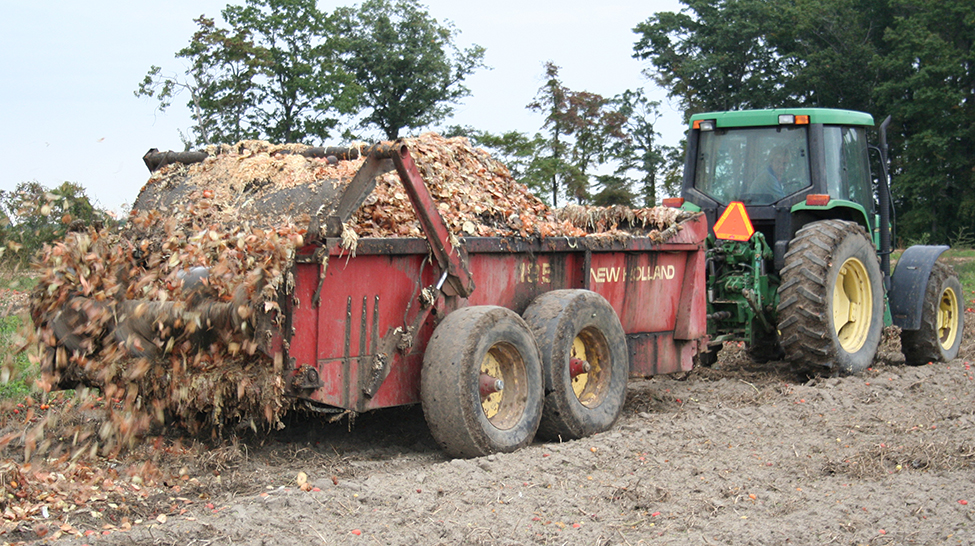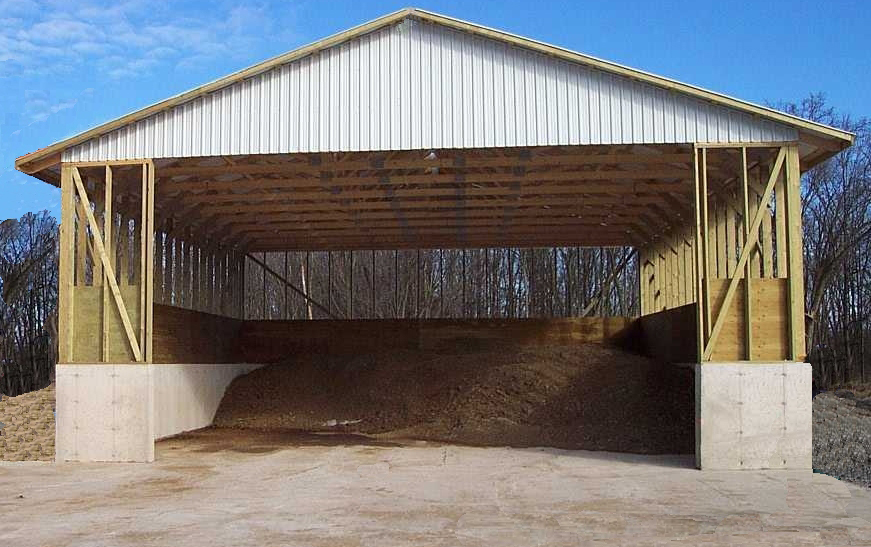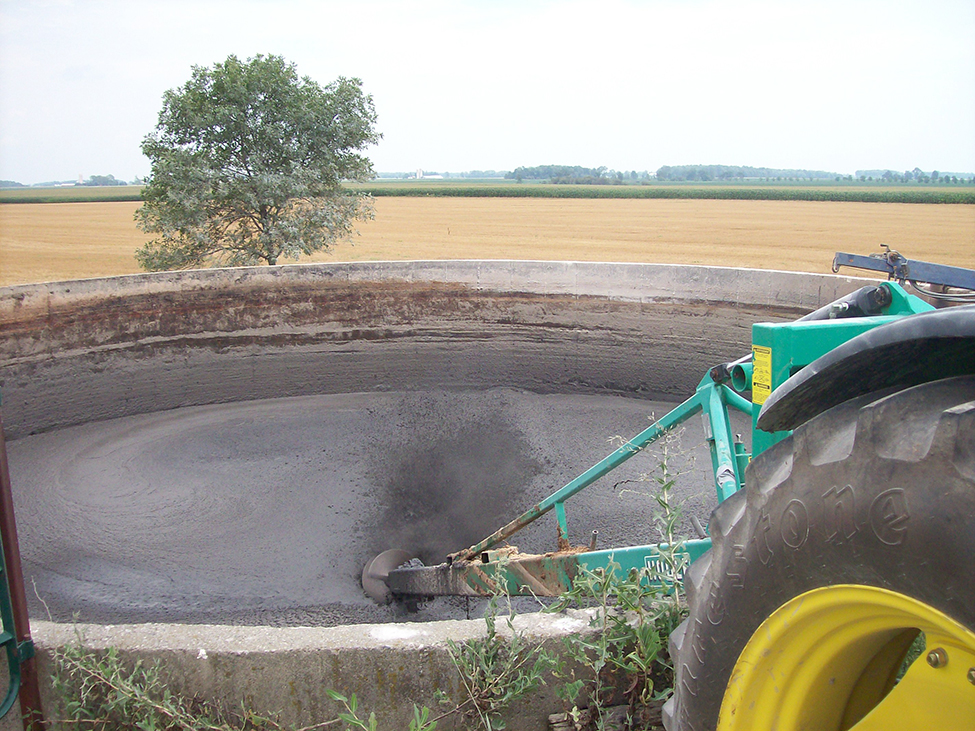Storage of non-agricultural source materials in a permanent nutrient storage facility
Learn about the requirements for the storage of non-agricultural source materials (NASM) when a NASM plan is required. This technical information is for Ontario producers.
ISSN 1198-712X, Published May 2023
Introduction
This fact sheet provides general guidance on the requirements for the storage of non-agricultural source materials (NASM) when a NASM plan is required. Most of the same rules apply to the storage of NASM where a NASM plan is not required, but some of the differences are discussed in this document.
NASM Plans are prepared by NASM Plan preparers who have been trained and certified by the Ministry of Agriculture, Food and Rural Affairs (OMAFRA). They are the first source of information on what is needed to get a NASM Plan approved.
This fact sheet does not address the storage of NASM in a structure that is subject to an Environmental Compliance Approval (ECA) under Part V of the Environmental Protection Act, 1990 (EPA).
Understanding NASM
NASM includes the following materials:
- sewage biosolids
- pulp and paper biosolids
- compost that does not meet Category AA or A as described in Part II of the Ontario Compost Quality Standards (2012)
- anaerobic digestion output, if less than 50%, by volume, of the total amount of anaerobic digestion materials treated in the mixed anaerobic digestion facility were on-farm anaerobic digestion materials
- any other material that is not from an agricultural source and is capable of being applied to land as a nutrient (for example, washwater and organic residues from food processing plants)
NASM categories
NASM are classified into 3 categories:
- Category 1 — unprocessed plant material (vegetable culls, Figure 1)
- Category 2 — processed plant material (organic waste materials from a bakery)
- Category 3 — municipal sewage biosolids, pulp and paper biosolids and animal-based material (organic residual material from a meat processing plan

The category determines if a NASM Plan is required to land-apply or store the NASM on the agricultural operation. An agricultural operation requires an approved NASM Plan if Category 2 or 3 NASM is stored in a NASM storage facility. A NASM Plan is not normally required if only Category 1 NASM is being stored.
Storage facilities located off the farm unit or storages constructed before June 30, 2003, cannot be regulated under a NASM plan and may require an ECA. The Ministry of Environment, Conservation and Parks (MECP) provides more information on the storage of NASM in a facility that is subject to an ECA or contact the local MECP office.
NASM odour considerations
NASM are also grouped into 3 odour categories: OC1, OC2 and OC3. OC1 is the least odorous material, and OC3 is the most odorous material allowed for land application. Any material that exceeds the OC2 category limits cannot be stored in a permanent NASM storage facility past midnight on the day it was received. Any material with an odour level that exceeds the OC3 odour category limit cannot be received at an agricultural operation for application on agricultural land as a NASM.
OC3 NASM must be applied to land by midnight of the day it is received at the farm. The NASM must be transferred to land application equipment using a closed transfer system such as a closed tank or bladder. In the case of solid OC3 NASM, the material must be covered with a rain-shedding tarp or waterproof covering. Otherwise, the stockpiling and transfer of NASM to the land application equipment must take place at least:
- 200 m from a dwelling, and
- 450 m from any residential area or commercial, community or institutional use
Table 3 of the Nutrient Management Tables, associated with O. Reg. 267/03 (the Regulation), lists materials that have been pre-assigned an odour category.
For more information on how the odour category of NASM is determined, read the OMAFRA fact sheet, Determining odour categories of non-agricultural source materials (NASMs), O. Reg. 267/03 and the NASM Odour Guide for Ontario.
NASM storage
This fact sheet does not address a temporary field storage site or portable tanks. Consult a certified NASM preparer for information on the storage of NASM at a temporary field storage site under the Regulation. Read the OMAFRA fact sheet, Temporary field storage of NASM.
A permanent NASM storage facility means a permanent structure, or part of a permanent structure, that is used to store NASM. It can include earthen structures or structures that had been used to store manure (once empty). However, the manure storages must have been legally constructed following an approved nutrient management strategy (NMS) (that is, they were not existing structures when the strategy was approved). A structure approved under the EPA, as part of a waste management system can also be used to store NASM in a NASM Plan.
Using an existing structure to store NASM requires proof that the storage was constructed under either a Nutrient Management Strategy Approval from OMAFRA or an ECA from the MECP. Except for small, solid NASM storages that meet all of the characteristics, the design and construction of new structures must be reviewed by a professional engineer to ensure they meet all legal requirements.
NASM stored in a permanent NASM storage facility cannot be transferred to another farm unit. A storage facility that is used to transfer materials to other farm units must have an ECA from the MECP.
Siting, construction and storage standards
This section summarizes the requirements for the siting and construction of structures storing NASM. Many of the requirements for storing agricultural source materials (ASM) are the same for storing NASM, so the information in OMAFRA fact sheets on ASM storage can be useful for understanding the requirements.
Rules and standards for permanent NASM storage facilities differ depending on whether an agricultural operation requires a NMS, a NASM Plan or none of these documents. They also depend on the category, dry matter content of the NASM (solid or liquid) and the size of the facility. A first step in determining the regulatory requirements for the storage of NASM is to determine if the operation requires an NMS or a NASM Plan.
When is an NMS or NASM plan required
An NMS may be required for an agricultural operation that has livestock, so confirm whether the operation has an NMS and how many nutrient units the operation generates. A nutrient unit is a measurement used in nutrient management planning that allows nutrient content of manure from various species to be compared. Cash crop operations are not required to have an NMS.
A NASM Plan is required to store or apply Category 2 or 3 NASM on an agricultural operation whether it is a livestock or cash crop operation. The storage or application of Category 1 NASM alone does not require a NASM plan; however, there are some requirements that apply to structures storing Category 1 NASM on farms without an NMS or NASM plan.
For more information on farm unit, nutrient units and the difference between an NMS or NASM Plan, read the OMAFRA fact sheet, When farms require a NMS, NMP or NASM plan.
Solid or liquid NASM storage
Solid NASM is material that has a dry matter content of 18% or more. A material with less than 18% dry matter may be classified as a solid if it has a slump of 150 mm or less using the Test Method for the Determination of Liquid Waste (slump test) as set out in Schedule 9 to Regulation 347 under the EPA.
Liquid NASM is defined as any NASM that is not solid NASM.
Storage facilities that contain only solid NASM are called permanent solid NASM storage facilities. Figure 2 is an example of a structure that stores solid NASM.

Storage facilities that contain liquid NASM are called permanent liquid NASM storage facilities. Figure 3 is an example of a structure that stores liquid NASM.

Small or large solid NASM storage
Solid NASM storage facilities are described as large or small. A small solid NASM storage has all of the following characteristics:
- a volume of less than 600 m3
- surface area of less than 600 m2
- walls that do not have an exposed height of more than 1 m
A large solid NASM storage facility is one that does not meet all of the above criteria for a small solid storage facility.
Siting standards
Siting requirements apply to all storages located on an agricultural operation that requires an NMS or NASM Plan, regardless of type or size.
The siting requirements specify the minimum separation distances (setbacks) from a storage facility to sensitive features such as wells, surface water and field drainage tiles. A NASM storage facility should:
- be located at least 15 m from a drilled well that has a depth of at least 15 m and a watertight casing to a depth of at least 6 m below ground level
- be located at least 100 m from a municipal well
- be located at least 90 m from any other well
- be located at least 15 m from drainage tiles (flow in tiles has been redirected away from the facility if necessary)
- have a flow path that is at least 50 m long to the top of bank of the nearest surface water or tile inlet
For more information on siting requirements, read the OMAFRA fact sheet, Siting requirements for permanent nutrient storage facilities.
Site characterizations
A site characterization is required for all new or expanding liquid storages on farm units that require an NMS or NASM Plan. It is also required for all large solid storages that do not have a concrete floor and are located on a livestock operation that generates 300 or more NU.
A site characterization study identifies the soil types and the presence of any aquifer or bedrock, all to a depth of at least:
- 1.5 m below the bottom of the excavation required for a concrete or steel tank
- 2.5 m below the bottom of the excavation required for an earthen storage
Hydrogeological and geotechnical investigations must be completed by a professional engineer or professional geoscientist in accordance with the Regulation. The qualified professional will analyze the data collected to determine the suitability of the site for the proposed type of storage. The study will also identify if a liner is required for a proposed liquid storage.
For more information on site characterizations, read the OMAFRA fact sheet, Site characterization study for the construction of permanent nutrient storage facilities.
Construction standards
The construction requirements and standards described in this section apply to all liquid storages and large solid NASM storages located on an agricultural operation with an NMS or NASM Plan. The Regulation does not specify general design, construction and liner requirements standards for NASM storage that are on agricultural operations that do not require an NMS or NASM Plan, but it specifies that all permanent NASM storage must have the structural integrity that is required for storing NASM.
A professional engineer must:
- design the construction or expansion of the structure, including the associated monitoring systems
- design the facility to be structurally safe and sound and minimize leakage and corrosion
- perform a general review of the construction or expansion to ensure it complies with the Regulation
- ensure that the design and construction of permanent nutrient storage facilities comply with other technical requirements outlined in the Regulation and summarized below
Permanent liquid nutrient storage facilities
Various requirements apply to all liquid storages located on an agricultural operation with an NMS or NASM Plan.
Liquid storages must be structurally sound and have secondary containment and ventilation requirements, where appropriate.
Earthen permanent liquid nutrient storage facilities
Unlined storage facilities made of earth cannot be used to store NASM. To store NASM in an earthen storage, the facility must have a synthetic or compacted soil liner and a minimum of 2 m of hydraulically secure soil separating the bottom and sides of the liner from bedrock or the uppermost identified aquifer. Ensure that the professional engineer hired to design and review the structure is familiar with all of the requirements of the Regulation.
For more information, in addition to the Regulation, read the OMAFRA fact sheets, Constructing a permanent concrete or steel liquid nutrient storage facility for ASM and Constructing an earthen liquid nutrient storage facility for ASM.
Permanent solid nutrient storage facilities
Floors
3 specific floor types are used for large solid NASM storages located on an agricultural operation with an NMS or NASM Plan. Small solid storages or large solid storages on an agricultural operation that does not require an NMS/P or NASM Plan are not limited to these 3 floor types.
Large solid NASM storage facilities can have 1 of 3 types of floors:
- a concrete floor
- a floor that a professional engineer determines will provide equivalent protection to a concrete floor
- a floor made of earth consisting of at least 0.5 m of hydraulically secure soil
Hydraulically secure soil is defined in the Regulation as natural soil that is consistent in nature and able to meet a maximum saturated hydraulic conductivity of 1 × 10-8 m/s.
For more information, read the OMAFRA fact sheet, Constructing a permanent solid nutrient storage facility for ASM.
Runoff management system
Runoff management is required for all permanent solid storages, regardless of size, on all agricultural operations, with or without an NMS or NASM Plan. A runoff management system must be capable of preventing, collecting, treating or containing runoff and consist of at least one of the following:
- a roof to prevent the entry of precipitation, if up‑slope water is diverted away
- a vegetated filter strip system
- a runoff collection and storage system that has the required storage capacity
- a permanently vegetated area, if up-slope water is diverted away
- a sewage works that is subject to ECA, issued under the Ontario Water Resources Act, 1990
- a sewage system regulated under Part 8 of the Building Code Act, 1992
For more information, see the OMAFRA fact sheet, Handling runoff from solid agricultural source material storages and outside livestock areas.
Odour emissions
A professional engineer must design a permanent NASM storage facility in order to minimize odour emissions. While there are no specific requirements for odour reduction, the professional engineer must show how the design of the facility will decrease odour emissions. Note that permanent nutrient storage facilities constructed between June 30, 2003, and January 1, 2011, in accordance with an NMS would not be subject to the requirement to minimize odour emissions.
Odour can impact neighbours and the community. As a best management practice, give extra attention to minimizing odour emissions from all NASM storage facilities, regardless of this specific requirement. Consider the following options:
- Install a permanent cover over the storage area to contain and treat the odours.
- Cover the surface of the liquid or solid with a layer of material that seals the surface, such as a layer of chopped straw blown onto the surface, or alternate layers of NASM with solid manure, soil or other material. This type of odour management requires a contingency plan to deal with the ongoing maintenance of the cover and any unexpected release of odours that escape from the storage.
As engineering standards and technology evolve, new and innovative ways to minimize odours from permanent NASM storage facilities are emerging. An engineer can help determine an appropriate method specific to the type of material, volume and days of storage.
Agitation of stored material also leads to odour emissions. This occurs when materials are transferred to or from the storage facility, or when materials are mixed prior to sampling or land application. Take care in the siting, design and operation of storage facilities to minimize the potential for odour impacts during these types of activities.
Summary
Whether a NASM plan is required or not, storing NASM to reduce the risks of impacts to the environment, including odours, contributes to maintaining public confidence in agricultural practices and continued access to these materials for agriculture. Work with a certified NASM Plan preparer, professional engineer, contractor and building official to ensure that the regulatory requirements are followed and risks are minimized. Both agriculture and society can benefit from the reuse of these materials.
This fact sheet was originally written by Benoit Lebeau, P. Eng., NASM specialist, OMAFRA, Mike Muffels, P. Eng., environmental specialist, OMAFRA, and Paul Sims, divisional program specialist, MECP. It was updated by Benoit Lebeau, P. Eng., NASM specialist, OMAFRA, and Dale McComb, environmental specialist, OMAFRA.